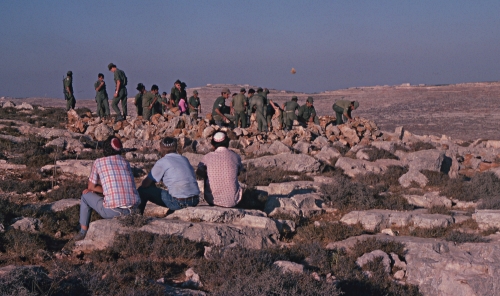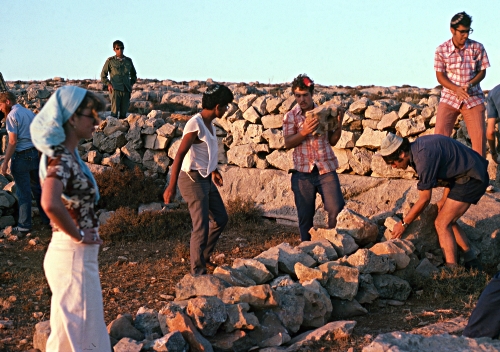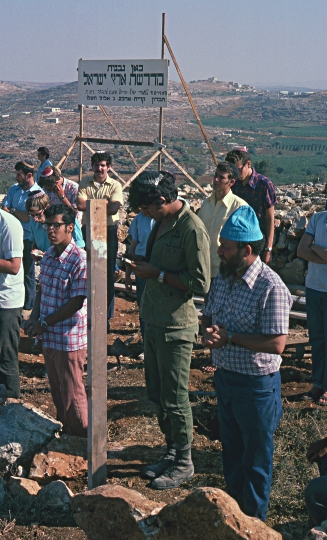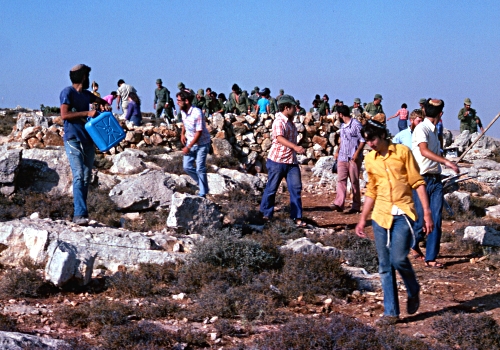Menachem's Writings
You're Known by the Company You Keep
We were only taking back what was rightfully ours
In Pirkei Avoth, the Mishnaic "Ethics of the Fathers", we are advised to distance ourselves from an evil neighbour. But it may be an edict not always easy to carry out.
My avid readers are only too familiar with my criminal circle:
- the boy downstairs, the infamous Coogee shoplifter,
- the gang of library thieves,
- the phone vandals,
- the band of counterfeiters,
- the Hungarian soccer striker,
- the Capo with the pistol
- Bentley, the crooked tractor salesman from across the road, and what list would be complete without an
- Insurance Agent or two.
Is it possible to have good friends like these and avoid their traits rubbing off onto you?
One sultry day back in August 1976, the then [Arab] mayor of [Arab] Hevron, Sheikh Muhammad Ali Ja'abri, scion of one of Hevron's prominent clans, met with King Hussein of Jordan at Amman. I well remember the Ja'abri house, mansion actually. Hevron is a poor city, but Ja'abri's residence dominates Hevron from the ridge to the north, the narrow crest which is a continuation of Givat Avot. We passed the manor house often, on the way from the Yeshiva to the the Ma'ara to pray, or to the Casba, the Hevron marketplace, to shop. Ja'abri owned a black stretch mercedes which was parked out front whenever he was home. His chauffeur too was as black as the ace of spades, a moslem originating I assume from somewhere in deep dark Africa. He continuously stood by the vehicle, awaiting his master's orders.
On this particular August day, the mayor returned from Amman, carrying a cheque from the little king for the then princely sum of four million pounds sterling. The money was earmarked for one purpose, and for one purpose only: to strangulate Kiryat Arba, from all sides with more and more Arab housing, houses that were not even always occupied. The strategy was clear. It was to establish facts on the ground. Already by this point in time, the Kirya was pretty well surrounded on three sides, only the west was still free of this illegal Arab housing. We were in possession of accurate maps, detailing the position of each house and the date of building. Kiryat Arba was barely six years old, and Arab building was massive in that short time, on land which they had previously ignored, not even cultivated, and previously had not even bothered to claim as their own.
 It was to populate the western direction from Kiryat Arba with new buildings that Hussein provided the money, and it was in that same direction that the people of the Kirya, in particular the students of our yeshiva, concentrated their efforts.
It was to populate the western direction from Kiryat Arba with new buildings that Hussein provided the money, and it was in that same direction that the people of the Kirya, in particular the students of our yeshiva, concentrated their efforts.
To the west of the Kirya, across an empty valley rose Givat Harsina, a bare hill, higher than the Kirya, rising well over 950 metres above sea-level. On this hill our fellow students decided to build a new yeshiva, Midreshet Erertz Yisrael.
The date was 3rd Elul, which, perhaps not by coincidence (is there such a concept?) was the 41st anniversary of the parting of Chief Rabbi Avraham Yitzhak haCohen Kook, father of our mentor, Rav Zvi Yehuda, the man behind the new settlement drive in Judea and Samaria.
Largely using stones from the area, the Kiryat Arbaians built. When the new structure reached about waist height, a group of Israeli soldiers were sent [only obeying orders] to destroy the building. Throwing the rocks in all directions, they returned the hill to its pristine state.
This scenario repeats itself once more later in the morning, in the early afternoon, and again towards sunset, almost ad nauseam. Each time, the demonstrators moved to another part of the hill and patiently, working together, repeated their earlier actions.
 Around lunchtime, I too leave the Beit Midrash, the study hall, with a few others, to join the builders, the demonstrators. We had just returned to our lecterns from the summer break two days earlier. Now by lunchtime on the third day, the hall had emptied. And this was Elul, the month of repentance, four weeks of introspection leading to the new year, a month in which Yeshiva students traditionally learn the hardest, study the longest. But our rabbis too were mostly out on the hill. Our Yeshiva continually educates towards the importance of building Eretz Yisrael, physically as well as intellectually. And we live our beliefs. Even a zealous student like me was drawn out of the hallowed sanctum, into action.
Around lunchtime, I too leave the Beit Midrash, the study hall, with a few others, to join the builders, the demonstrators. We had just returned to our lecterns from the summer break two days earlier. Now by lunchtime on the third day, the hall had emptied. And this was Elul, the month of repentance, four weeks of introspection leading to the new year, a month in which Yeshiva students traditionally learn the hardest, study the longest. But our rabbis too were mostly out on the hill. Our Yeshiva continually educates towards the importance of building Eretz Yisrael, physically as well as intellectually. And we live our beliefs. Even a zealous student like me was drawn out of the hallowed sanctum, into action.
A brisk fifteen minute walk across the valley and we arrive at the building site, in time to join in the second (or was it the third) round of building. It's a warm day, but we don't notice. We work as fast as we can. Turkish law, which is still officially relevant under the present Israeli jurisdiction, states that once a structure, built on Crown Land, has four walls and a roof, it can not be legally destroyed. A variation of this statute was used by our Zionist pioneers in the thirties to build many new kibbutzim overnight, against the wishes of the British mandatory government. Of course the Israeli government, unlike the English, don't always play fair in snowball fights.
 We aim to quickly get the building to a reasonable height and top it with a roof. The army's contrary goal is to ensure we never complete a roof, preferably not even high walls. It's a game of cat and mouse. They keep their distance, but keep an eye on us. The press is here, but will they report our activities, write about our plight? Probably not. In the seventies, as today, the Press is largely the domain of the Left.
We aim to quickly get the building to a reasonable height and top it with a roof. The army's contrary goal is to ensure we never complete a roof, preferably not even high walls. It's a game of cat and mouse. They keep their distance, but keep an eye on us. The press is here, but will they report our activities, write about our plight? Probably not. In the seventies, as today, the Press is largely the domain of the Left.
Following the fourth military destruction of our midrasha, we decide to settle down for the night. We put down the bottom rows of rocks for the last building attempt of the day as the sun was setting. It was getting too dark to continue our construction work. There were about twenty five of us, including our class rabbi, Rav Yair. Rav Yair always came to these demonstrations, always coming with his survival kit: his tallith, tefilin, clean underwear and whatever work of Rav Kook he is currently learning, all carried in a little khaki shoulder bag.
Suddenly two Swedish tourists arrive, in the almost darkness. I don't think they are Jewish, but they just turned up at the Kirya and asked where where the could stay. Some wit pointed them in the our direction.
We light a camp fire. Even though it's August, the evenings at this altitude are cool. No-one other than the Swedes, sleep. We sing, we talk -- we are excited -- we are the first true Zionist pioneers since the war of independence. We are reasonably certain the army will return. Or just come over the hill. We can't see them, but presumably they are close by.
 At about 2 a.m. they are suddenly amongst us. We can barely make them out in the dimming embers. They start putting us into a truck at the foot of the hill. It is easy to escape, and many do. I don't have a weapon -- all the Israelis carry an uzi submachine gun, the standard issue for the tank brigade -- nearly everyone in our yeshiva is in tanks. I didn't feel safe crossing the valley alone in the dark night, so I don't make a run for it. Rav Yair also without a rifle, is in the truck too. The Swedes are dazed when they wake up. They thought they were on a friendly country sleepover, under the stars. The soldiers quickly figure out they have nothing to do with our cause.
At about 2 a.m. they are suddenly amongst us. We can barely make them out in the dimming embers. They start putting us into a truck at the foot of the hill. It is easy to escape, and many do. I don't have a weapon -- all the Israelis carry an uzi submachine gun, the standard issue for the tank brigade -- nearly everyone in our yeshiva is in tanks. I didn't feel safe crossing the valley alone in the dark night, so I don't make a run for it. Rav Yair also without a rifle, is in the truck too. The Swedes are dazed when they wake up. They thought they were on a friendly country sleepover, under the stars. The soldiers quickly figure out they have nothing to do with our cause.
At 2:30, eleven of us arrive at the large old British Tagart fort in Hevron. This served as the command post of Israeli military government. They put us into the soldiers' recreation room. "We'll be back in the morning to deal with you", leaving a guard at the door. The guard fell asleep and two more of our number sneak out.
We slept on the floor and were awaken by our friends who brought our tefilin to us. We prayed in the rec room. No-one came to get us, nor even related to us. They eventually bought us some apples -- someone must have remembered we need to be fed. We found out later that there was a terrorist alert in the city. We actually heard and saw helicopters landing and taking off outside.
We eventually eat breakfast at about one o'clock. We just hang around, I guess until they got sick off us, and we eventually return to the Yeshiva late that night. Of course having your rabbi with you in your incarceration means that you don't need to miss out on your lessons. Rav Yair gives a number of lectures on aspects of Rabbi Kook's philosophy.
Today our hill is called Givat Mamre, after our father Abraham's friend, who advised him to obey haShem's command to circumcise himself at the advanced age of 99. Avraham's other friends tried to talk him out of the act. In honour of his confidant, Avraham performed the circumcision while camped on Mamre's property. These fields are said to be just below the current site. Today Givat Mamre is home to many hundreds of Jewish families.
I would like to think that I had a very small part in this.
Menachem Kuchar, 4th August, 2009
14th Menahem Av, 5769
Please feel free to
and don't forget to stop by my site to look at my latest (and classic) photographs.
Enjoy!
Previous posts:
- Stories HomePage
- How Much Would You Pay to Get a Million Dollars?
- A Most Humbling, Though Frustrating Experience
- What Do Coffee, Tomatoes and Red Wine Have in Common?
- They're Out to Kill Us! -- No I am not paranoid
- Liars, Damned Liars and Insurance Agents
- On Messier Madoff and Ponzi and all those who were sucked in
- A Time to Pick Sides -- the time to sit on the fence has ended
- Of HUSSEIN Obama, Elie Wiesel, Cairo and Buchenwald
- Hevron in Those Days and Now
- The Secret Art of Bread Making and preparation of edible food
- The Conquest of Hevron, the City of Our Forefathers
- My First Writing Anniversary: Torah V'Avodah
- Whose Land Is This?
- Capos, Kapos and Nazi Murder Inc. Could the Germans have done it on their own?
- The Entire World Must be Upside Down! Passover Eve in Yerushalayim
- The Shattering of the Myth -- the Jews of the Galut/Disapora and the Jews of Israel
- Smuggling out of the Soviet Block
- The Smell Just Isn't Going Away
- Skeletons in My Closet or I think I may smell a rat
- Some Benefits in Discovering Your Long Lost Relatives
- Having a Happy Purim and Surviving Mishloach Manot
- The Morality of Diet and Humane Eating -- How a Jew should view eating to live
- Memories of my Father
- Cogito ergo sum -- I Think, Therefore I Am; I Don't Think, Therefore Perhaps I Am Not -- What's all this Doublespeak?
- Vibrant Colours and the Return of a King to Israel
- My Uncle the Soccer Star
- So What's in a Name